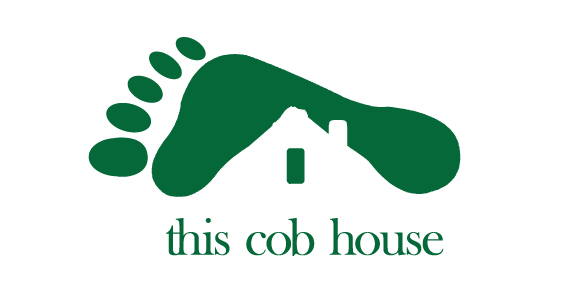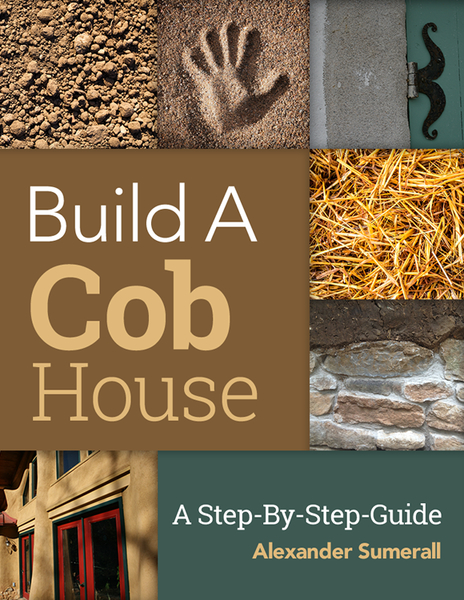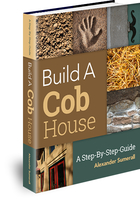What is a Cob House Foundation?
The first part of building your cob house will be the foundation. This is the first major component to consider when building any structure, and the information presented in this chapter will be relevant to most types of buildings. The foundation is a unified, stable base which holds the weight of your walls, upper floors, roof, and any live loads. It also distributes the weight of the house over a larger area and helps prevent the building from sinking into the ground, which can be catastrophic to a structure. You must build on solid, dry ground with good soil drainage.
Cob house foundations can be built using a variety of materials, but they are mostly built with solid, non-corroding materials like concrete or stone. A good foundation is vital to the life of your building and it should be given the thorough consideration it deserves as a critical piece of the structure.
Foundations for cob buildings can include the footers below ground and the above-ground stem wall that holds the cob walls above grade. The footers below ground level work with the stem wall to further distribute the weight of the building evenly and to anchor the building into the ground.
The stem wall, which extends above ground on top of the footers, stands at least 1 ½ feet above ground level. The stem wall acts as protection for the earthen walls from water damage. It acts as a moisture break so that water does not seep up from the ground into the walls. Water runoff along the ground is also not able to touch the cob portion of the walls, and water splash-back from rainfall cannot reach the height of the cob walls.
It’s important for your foundation to protect your walls from water since cob walls will deteriorate if they are exposed to water. Even in arid climates, it is not recommended to build the cob walls starting at the ground level as this shortens the life of the structure. You still want to have a raised stem wall.
Especially for earthen building, the importance of foundations cannot be overemphasized. Do your due diligence and plan for a solid, strong foundation. If your foundation is well designed, your building will enjoy a much longer life.
Foundation Components
There are a few main components that will make up the foundation for a house.
Footers
Foundation footers are the deepest part of your foundation and sit underground beneath the foundation stem walls. Footers support the foundation and help prevent it from settling. They are wider than the actual width of the foundation stem walls.
Stem Walls
The stem wall sits on top of the underground foundation footers and they extend above-ground. Stem walls for earthen buildings should generally rise between 1.5 to 2 feet above ground level. This portion of the foundation acts as a moisture break between the ground and the walls, and further integrates the building into the solid ground beneath it.
Reinforcing
Steel reinforcing, also called rebar, is used throughout any concrete foundation components, such as the footers and stem walls. Rebar strengthens concrete and holds it in tension, similar to how straw fiber acts within cob.
Drainage
A good foundation will also have a drainage system along the outside perimeter. The drainage system should keep excess water away from the foundation components. Water collection around foundations can cause leaks and frost heave.
Foundation Materials
There are many kinds of materials and alternative materials that are used for foundations. In this section, I’m going to categorize them very distinctly as either good or bad materials for foundations. I have seen too many very poor examples of foundations for earthen buildings that have led to a myriad of problems for them. I would be doing you a disservice if I tried to sell you a fantasy that many other people try to do that you can build strong foundations with recycled or alternative materials. These alternatives only work in isolated instances. Let’s begin with the materials you do want to use for foundations.
Stone
To be honest, I’m only putting stone in the “good” category because it has been used successfully for foundations throughout time. Even with this being the case, I very rarely recommend that anyone attempt to build a traditional stone foundation for their home these days. They are expensive, the vast majority of masons don’t know how to build stone foundations anymore, and getting a building permit for one is nearly impossible.
With all that being said, stone has a place in foundations and you might be able to use it for yours. Stone is a good natural option if you are not interested in using concrete. Stone also has an appealing aesthetic look to it when put together properly, and it nicely complements the earthen tones and organic shapes of cob.
Building a stone foundation is a labor intensive process and can take a long time. It also requires some skill. If you are going to build your own stone foundation, please get proper training from a skilled stone mason. Stone foundations are not slapped together. They are carefully crafted.
Stone is a decent choice for stem walls. It would be a good idea to place a stone stem wall on top of concrete footers though.
Concrete
Concrete is a mixture of aggregates (like we use in cob) and cement binder. Concrete is my top recommendation for foundation material. Any competent builder in the modern age will not gripe with the fact that concrete works the best for foundations in the vast majority of cases.
A few people decide not to use concrete because of cement’s high embodied energy. This means that it requires a high amount of energy and fossil fuels to be burned for its production, transport, and application. This is true, but don’t rule out using concrete because of this. For the embodied energy of the concrete you use, you will save more embodied energy and timber overall by building your walls with earthen material. It’s still a net positive as far as embodied energy goes.
Concrete has been used for thousands of years by builders for good reasons. It is a great material for foundations. It’s monolithic, very strong, widely available, it uses 99% natural ingredients, and it can be poured into almost any shape that you want.
Concrete is a great choice for footers and stem walls!
Bricks or Blocks
Fired bricks or concrete blocks can be used for stem wall construction. They have been used for thousands of years for this purpose all over the world. They are easily stackable and go up quickly. However, bricks and blocks are not monolithic and you will have to build them out to whatever the thickness of your earth walls will be. Again, this will not be an easy option for getting building approvals on. If you want the brick-look for a foundation, you can always add a brick veneer to the side of a concrete stem wall.
Bricks and blocks might be an option for stem walls on top of a concrete footer.
Polypropylene Bags
Woven polypropylene bags are sometimes used for foundations on alternative buildings, such as superadobe structures. These types of structures are systems that work in very dry, arid climates. I do not ever recommend polypropylene bags for foundations though.
The concept is to fill the bags with gravel and stack them up into a foundation. This will most definitely lead to a weak foundation that won’t last long. The bags easily tear and they also degrade under sunlight. You will have a foundation full of spilling holes by the time you are halfway complete building your walls, and the whole structure will need to be torn down at that point.
Avoid polypropylene bags like the plague for foundations.
Tires
Another popular alternative material that’s sometimes used for foundations is tires. The tires are stacked together and each tire is filled with compressed soil. This system is used successfully for the Earthship system. Again, the Earthship buildings are designed mostly for dry, desert climates. Please do not attempt to build a tire foundation in any climate with normal rainfall. Water will leak through the foundation and saturate the compressed soil inside them.
Tires might only be a good option if you’re building a cob pig pen.
Urbanite
Urbanite is salvaged pieces of broken up concrete (usually sidewalks) that can be used to stack like stones. Urbanite has all the downsides of bricks, blocks, stones, and more. The pieces are un-uniform and you will never get building permits to use it for a home foundation.
Urbanite may be a decent option for a small shed foundation if you really want to go this route.



